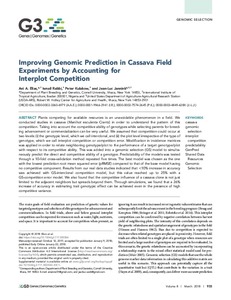| dc.contributor.author | Elias, A.A. |
| dc.contributor.author | Rabbi, I. |
| dc.contributor.author | Kulakow, P. |
| dc.contributor.author | Jannink, Jean-Luc |
| dc.date.accessioned | 2019-12-04T11:21:47Z |
| dc.date.available | 2019-12-04T11:21:47Z |
| dc.date.issued | 2018-03 |
| dc.identifier.citation | Elias, A.A., Rabbi, I., Kulakow, P. & Jannink, J.L. (2018). Improving genomic prediction in cassava field experiments by accounting for inter-plot competition. G3: Genes, Genomes, Genetics, 933-944. |
| dc.identifier.issn | 2160-1836 |
| dc.identifier.uri | https://hdl.handle.net/20.500.12478/3873 |
| dc.description | Open Access Journal |
| dc.description.abstract | Plants' competing for available resources is an unavoidable phenomenon in a field. We conducted studies in cassava (Manihot esculenta Crantz) in order to understand the pattern of this competition. Taking into account the competitive ability of genotypes while selecting parents for breeding advancement or commercialization can be very useful. We assumed that competition could occur in two levels i) at the genotypic level, which we called as inter-clonal, and ii) at the plot level irrespective of the type of genotype, which we call as inter-plot competition or competition error. Modification in incidence matrices was applied in order to relate neighboring genotype/plot to the performance of a target genotype/plot with respect to its competitive ability. This was added into a genomic selection model to simultaneously predict the direct and competitive ability of a genotype. Predictability of the models was tested through a 10-fold cross-validation method repeated five times. The best model was chosen as the one with the lowest prediction root mean squared error (pRMSE) compared to that of the base model having no competitive component. Results from our real data studies indicated that less than 10% increase in accuracy was achieved with GS-inter-clonal competition model but this value reached up to 25% with a GS-competition error model. We also found that the competitive influence of a cassava clone is not just limited to the adjacent neighbors but spreads beyond them. Through simulations we found that a 26% increase of accuracy in estimating trait genotypic effect can be achieved even in the presence of high competitive variance. |
| dc.description.sponsorship | Bill & Melinda Gates Foundation |
| dc.description.sponsorship | Department for International Development, United Kingdom |
| dc.format.extent | 933-944 |
| dc.language.iso | en |
| dc.subject | Cassava |
| dc.subject | Manihot Escultenta |
| dc.subject | Genomics |
| dc.subject | Prediction |
| dc.subject | Resources |
| dc.subject | Genotypes |
| dc.title | Improving genomic prediction in cassava field experiments by accounting for interplot competition |
| dc.type | Journal Article |
| dc.description.version | Peer Review |
| cg.contributor.crp | Roots, Tubers and Bananas |
| cg.contributor.affiliation | Cornell University |
| cg.contributor.affiliation | International Institute of Tropical Agriculture |
| cg.contributor.affiliation | United States Department of Agriculture |
| cg.coverage.region | Africa |
| cg.coverage.region | West Africa |
| cg.coverage.country | Nigeria |
| cg.creator.identifier | Ismail Rabbi: 0000-0001-9966-2941 |
| cg.creator.identifier | Peter Kulakow: 0000-0002-7574-2645 |
| cg.creator.identifier | Jean-Luc Jannink: 0000-0003-4849-628X |
| cg.researchtheme | BIOTECH & PLANT BREEDING |
| cg.isijournal | ISI Journal |
| cg.authorship.types | CGIAR and advanced research institute |
| cg.iitasubject | Cassava |
| cg.iitasubject | Genetic Improvement |
| cg.iitasubject | Plant Breeding |
| cg.iitasubject | Plant Genetic Resources |
| cg.iitasubject | Plant Production |
| cg.journal | G3: Genes, Genomes, Genetics |
| cg.howpublished | Formally Published |
| cg.accessibilitystatus | Open Access |
| local.dspaceid | 96740 |
| cg.targetaudience | Scientists |
| cg.identifier.doi | https://dx.doi.org/10.1534/g3.117.300354 |

